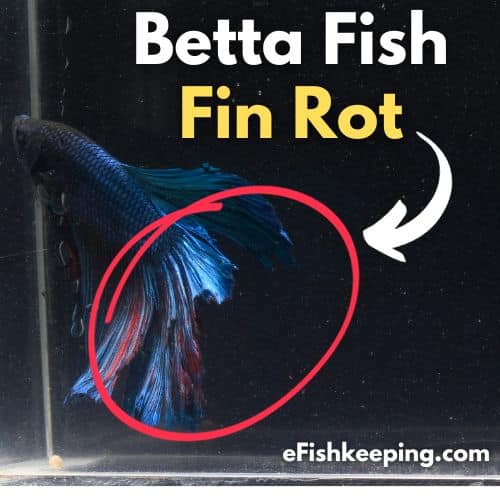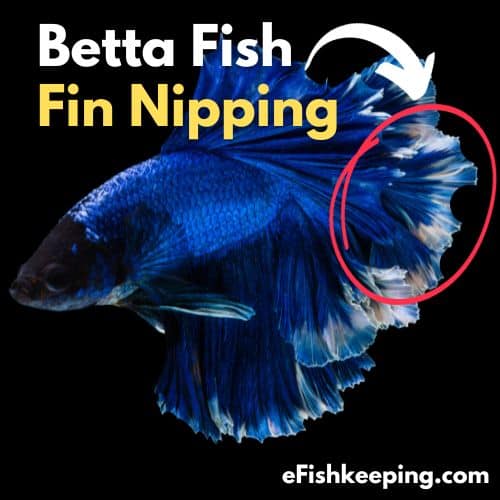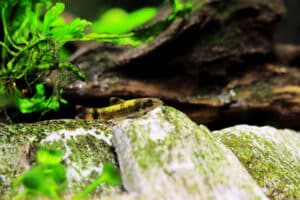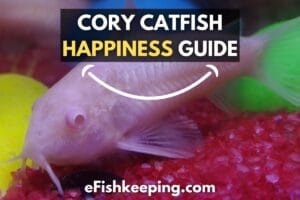Need help distinguishing between fin rot and fin nipping?
Don’t worry, you’ve come to the right place!
Keep reading to learn how to identify fin rot and fin nipping in your fish, as well as other important information related to these conditions.
With the right knowledge and care, you can keep your fish healthy and happy.
Fin Rot vs. Fin Nipping
| Key Points: | Fin Rot: | Fin Nipping: |
| Definition | Gradual deterioration of fin tissue caused by bacterial or fungal infection | Damage to fins caused by nibbling or biting from other fish |
| Appearance | Frayed, ragged fins; redness/inflammation; loss of fin tissue; pale or discolored fins | Bite marks, tears, or missing pieces of fins |
| Causes | Poor water quality, physical injury, infections, nutrient deficiencies | Aggression, dominance behavior, boredom, stress, territorial disputes |
| Treatment | Improve water quality, treat with antibiotics, address underlying issues | Separate aggressive fish, reduce stressors, provide stimulation |
| Prevention | Maintain good water quality, quarantine new fish, avoid overcrowding, prevent temperature shocks, provide balanced diet | Choose compatible tank mates, prevent boredom, provide adequate space and hiding spots |
| Fin Regrowth | Fins often regrow over time if underlying issue is addressed | Fins typically regrow provided fish remains healthy |
Fin Rot Or Fin Nipping: How To Identify?
What Does Fin Rot Look Like:

Here are some common signs to identify if it is a fin rot:
- Frayed or ragged fins: The edges of the affected fins may appear frayed or ragged as if they are being eaten away.
- Redness or inflammation: The skin around the affected fins may be red or inflamed.
- Loss of fin tissue: The affected fins may appear shorter than normal, and you can notice the loss of fin tissues.
- Color changes: The affected fins may become discolored or take on a pale or translucent appearance.
Pro-Tip: In mild cases of fin rot, you’ll see white edges. But as the deterioration spreads, the fin edges start appearing black. In serious cases of fin rot, outgrowth and inflammation occurs in the area, and it can also results in major loss of fin tissues.
I’ll share about the treatment for Fin rot in the following sections of this article (So stay tuned!) But what if you already applied the treatment and aren’t sure if it’s working or not? Then I highly recommend you read this guide: How To Tell If Fin Rot Is Healing? Signs To Know & Tips To Cure!
What Does Fin Nipping Look Like:
Here are some common signs that a fish has become the target of fin nipping:
- Bite marks or injuries on the fins or tail: The affected fins may have bite marks or other injuries, such as tears or scratches.
- The appearance of gaps or missing parts in fins: In severe cases of fin nipping, a fish may have missing fins or large gaps in their fins.
- Changes in behavior: The fish may exhibit changes in behavior, such as becoming more aggressive or withdrawn, or they may become more prone to hiding or seeking shelter.
- Changes in swimming patterns: The fish may change their swimming patterns, such as swimming more erratically or avoiding certain areas of the tank.
If your fish continuously swims in circles then you might also want to check out this guide for causes and fixes: Why Do Fish Swim In Circles?
Why Do Fish Nip Their Own Fin?

Some fish, especially bettas, are well-known for biting and nipping their own tail fins. Here are some possible reasons why a betta fish may nip at its own fins:
- Stress: Betta fish are sensitive to changes in their environment and may become stressed if they are not provided with a suitable habitat or subjected to sudden changes in temperature or water quality. Nipping at their fins can be a sign of stress in betta fish.
- Boredom: Betta fish need mental and physical stimulation to stay healthy and happy. If a betta fish does not have enough to do, it may become bored and start nipping at its fins to alleviate boredom.
- Poor environmental conditions: Betta fish need a clean, well-maintained habitat to thrive. If the water quality is poor, or the tank is too small or lacks hiding places or other forms of enrichment, a betta fish may become stressed and start nipping at its fins.
- Habit due to hereditary factors: Lastly, you may notice that whatever optimal conditions you offer to your betta fish, it will still bite his tail. And if that’s the case, then the reason could be a result of hereditary. Betta fish are naturally aggressive, and their tail-nipping behavior is sometimes linked with heredity.
Why Do Some Fish Nip Other Fish’s Fins?
Fish may nip the fins of other fish for a variety of reasons. In some cases, fin nipping may signify aggression or dominance, particularly if the fish are housed in a crowded or confined space.
A fish may also nip the fins of other fish as a means of establishing a social hierarchy or as a way to defend their territory.
Fin nipping can also be a sign of stress in fish. For example, if a fish is subjected to poor water quality, inadequate space, or other forms of environmental stress, it may become more prone to nipping the fins of other fish.
Finally, some fish are popularly known in the aquarium hobby as “fin nippers.” Fin nipper fish are those that tend to nip the fins of other fish in an aquarium setting.
If you house these fin-nipper fish with other fish that have flowy and delicate fins, such as betta fish and guppies, expect to notice fin nipping.
One of the most well-known fin-nipping fish is the tiger barb. These small, active fish are known for their playful and energetic nature but can also be aggressive and prone to fin-nipping.
Fin Rot Causes:
Fin rot is a common and potentially serious condition that affects the fins of fish, and the gradual erosion and disintegration of the fins characterize it.
Various factors can contribute to the development of fin rot in fish, including:
#1. Poor water quality:
A common cause of fin rot is poor water quality. Fish are sensitive to changes in their environment, and if the water is not properly maintained, it can lead to bacterial infections and other health issues.
Several factors, including an accumulation of waste and toxins, low oxygen levels, and high ammonia or nitrite, can cause poor water quality.
#2. Physical Injury:
Fin rot can also be caused by physical trauma to the fins, such as bites from other fish or injuries sustained in the aquarium or pond.
Physical trauma can damage the tissue of the fins and create an opening for bacteria to enter and cause an infection.
#3. Infections:
Fish can be infected with fin rot if exposed to other infected fish or if they are stressed or weakened due to other underlying health issues.
Fin rot is a common yet serious condition that affects fish fins and is usually caused by a bacterial infection. However, it can also be caused by a fungal infection or even a combination of both.
The primary cause of fin rot is often environmental, stemming from stress or poor water quality, weakening a fish’s immune system and making it more susceptible to infection.
#4. Nutrient Deficiencies:
A lack of certain nutrients in the diet can also contribute to fish fin rot development. Nutrient deficiencies can weaken the immune system and make the fish more prone to infections and other health issues.
Fin Rot Treatment:
One way to treat fin rot is by using medication such as Melafix or Aquarisol, which can help to kill the bacteria that cause the condition.
It is important to identify and consider removing any underlying causes of stress, such as poor water quality or other factors, that may have contributed to the development of fin rot.
As these causes are corrected, antibiotics should be effective in treating the disease.
Additional Resource: Fin Rot Treatment Article by Aquarium Coop
Fin Rot Prevention:
There are several steps you can take to help prevent fin rot in fish:
#1. Maintain Good Water Quality:
One of the most important things you can do to prevent fin rot is to maintain good water quality in your aquarium or pond. This includes regular testing and adjusting the pH, nitrite, nitrate, and ammonia levels in the water and performing regular water changes to remove excess waste and toxins.
#2. Quarantine New Fish:
When introducing new fish to your aquarium or pond, it is important to quarantine them for some time to ensure they are healthy and free of any infections or diseases.
#3. Avoid Overcrowding:
Overcrowding can lead to stress and aggression in fish, increasing the risk of fin rot. Make sure to provide your fish with enough space and hiding places to allow them to feel comfortable and secure.
#4. Avoid Temperature Shock:
Rapid temperature changes can stress fish and weaken their immune systems, making them more prone to fin rot and other health issues. So avoid that to ensure their optimal health.
#5. Provide A Balanced Diet:
A healthy diet is essential for the overall well-being of your fish. Make sure to provide a variety of high-quality, nutrient-rich foods to help support their immune systems and prevent fin rot and other health issues.
In a nutshell, provide a better environment for the fish, and reduce the causes of stress, and that should help you prevent fin rot in fish.
Do Nipped Fins Regrow?
In many cases, fish fins that have been nipped or damaged will regrow over time.
Fish can regenerate damaged fins and other body parts, and as long as the fish is healthy and the underlying cause of the fin damage is addressed, the fins will usually regrow.
However, the rate of fin regrowth can vary depending on the severity of the damage and the overall health of the fish. In some cases, fin regrowth may be slow, and it may take several weeks or months for the fins to regenerate fully.
In other cases, fin regrowth may be more rapid, particularly if the fish is young or the damage is not too severe.
How To Stop Fin Nipping?
There are several steps you can take to help prevent fin nipping in your fish:
#1. Provide Them Right Condition To Live
Give your fish proper water conditions to live, and give them a proper well-balanced diet.
Overcrowding and a lack of appropriate hiding places can lead to stress and aggression in fish, increasing the risk of fin nipping. Make sure to provide your fish with enough space and hiding places to allow them to feel comfortable and secure.
#2. Choose Compatible Fish Species:
Different fish species have different social and territorial behaviors. Therefore, it is important to research the specific needs and behaviors of the fish you are considering keeping in your aquarium to ensure that they are compatible with one another.
Also, it’s good to avoid housing fin nippers like tiger barbs with fish that have delicate and flowy fins like guppy fish.
#3. Prevent Boredom In Fish
Fish also need mental and physical stimulation to stay healthy, happy, and active.
Boredom in fish can lead to various problems, including poor appetite, lethargy, and problem behaviors such as fin nipping.
Here are some steps you can take to help prevent boredom in your fish:
- Provide A Spacious And Enriched Environment: Fish need plenty of space to swim and explore, and they benefit from various hiding places, plants, and other decorations to provide mental and physical stimulation.
- Offer A Varied Diet: Feeding your fish a variety of high-quality, nutrient-rich foods can help to keep them interested and engaged. In addition, consider offering a mix of different types of foods, such as frozen or live foods, to provide additional stimulation.
- Consider Adding Compatible Tankmates: Some fish are more social, while others exhibit schooling behavior. So depending on the type of fish, adding compatible tank mates in the tank will allow them to interact and have some positive stimulation.
Just be sure to research the specific needs and behaviors of the fish you are considering adding to your tank to ensure they are compatible with your existing fish.
Wrapping Up
Fin rot and fin nipping are common conditions that can affect fish fins. While they may appear similar at first glance, these conditions have different causes and require different approaches to handle.
It is important to identify and distinguish between fin rot and fin nipping in to provide the appropriate care and treatment for your fish.
By understanding the signs and symptoms of these conditions and taking steps to prevent and treat them, you can help ensure your fish’s overall health and well-being.
Read Also: Can Fish Survive Ich Without Any Treatment?
Hi! I’m Praveen Ghoshal, the founder of eFishkeeping.com. Inspired by my Dad, I got interested in fishkeeping when I was a kid. Since then, I have been involved with this hobby. Currently, I have 3 fish tanks at our home, and I enjoy this hobby with my full family. Read more about me here.





![Do Neon Tetras Die Easily? [Here’s The Truth!] do-neon-tetras-die-easily](https://efishkeeping.com/wp-content/uploads/2023/03/do-neon-tetras-die-easily-300x200.jpg)


